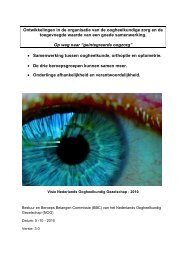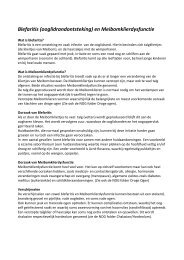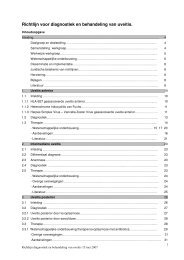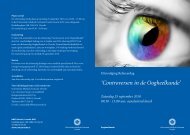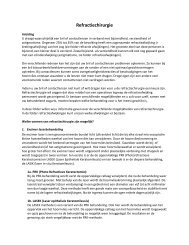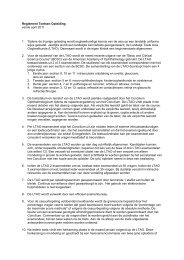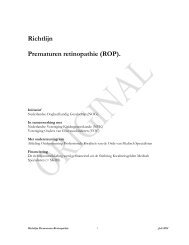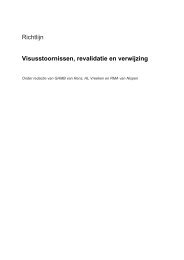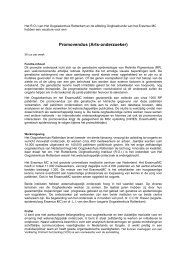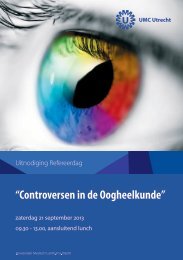terminology and guidelines for glaucoma ii - Kwaliteitskoepel
terminology and guidelines for glaucoma ii - Kwaliteitskoepel
terminology and guidelines for glaucoma ii - Kwaliteitskoepel
Create successful ePaper yourself
Turn your PDF publications into a flip-book with our unique Google optimized e-Paper software.
In case of a narrow approach, it is possible to improve the visualization of the angle recess by having the patient rotate<br />
the globes towards the mirror being used.<br />
Problems<br />
Related to the technique<br />
The most widely used technique is indirect gonioscopy where the angle is viewed in a mirror of the lens. The position of the<br />
globe is influential. If the patient looks in the direction opposite of the mirror the angle appears narrower <strong>and</strong> viceversa.<br />
A second pitfall is related to the degree of pressure of the lens against the cornea <strong>and</strong> especially occurs when the diameter of<br />
the lens is smaller than the corneal diameter (as with the small Goldmann lens, the Posner or the Zeiss lenses). This effect is<br />
useful <strong>for</strong> indentation or dynamic gonioscopy with the Posner or Zeiss lenses; inadvertent pressure over the cornea however,<br />
will push back the iris, <strong>and</strong> gives an erroneously wide appearance to the angle. With the Goldman lens indentation is transmitted<br />
to the periphery of the cornea <strong>and</strong> narrows the angle.<br />
Related to the anatomy<br />
Recognition of angle structures may be impaired by variations in the anterior segment structures like poor pigmentation, iris<br />
convexity or existence of pathological structures. The examiner should be familiar with all the anatomical structures of the<br />
angle: Schwalbe’s line, trabecular meshwork, scleral spur, ciliary b<strong>and</strong> <strong>and</strong> iris.<br />
Pharmacological mydriasis<br />
Dilation of the pupil with topical or systemic drugs can trigger iridotrabecular contact or pupillary block, eventually leading<br />
to angle-closure. Angle-closure attacks can occur, even bilaterally, in patients treated with systemic parasympatholytics<br />
be<strong>for</strong>e, during or after abdominal surgery <strong>and</strong> has been reported with a serotonergic appetite suppressant.<br />
Although pharmacological mydriasis with topical tropicamide <strong>and</strong> neosynephrine is safe in the general population even in<br />
eyes with very narrow approach, in occasional patients raised IOP <strong>and</strong> an angle occlusion can be observed.<br />
Theoretically, although any psychoactive drugs have the potential to cause angle-closure, it is unlikely that pre-treatment<br />
gonioscopy findings alone are of help to rule out such risk. In eyes with narrow angles, it makes sense to repeat gonioscopy<br />
<strong>and</strong> tonometry after initiation of treatment. Prophylactic laser iridotomy needs to be evaluated against the risks of<br />
angle-closure or of withdrawal of the systemic treatment. (See Chapter 2 - 4). None of these drugs is contraindicated per<br />
se in open-angle <strong>glaucoma</strong>.<br />
Ciliochoroidal detachment with bilateral angle-closure has been reported after oral sulfa drugs.<br />
Since patients most commonly have mixed components of angle-closure, gonioscopic appearances are seldom clear-cut as<br />
far as determining the etiology.<br />
The visualization during gonioscopy of the ciliary processes through the undilated pupil is a sign of <strong>for</strong>ward displacement<br />
of the iris <strong>and</strong> of the anterior lens surface, associated with anterior rotation of the ciliary body.<br />
1.2.3 - GRADING<br />
The use of a grading system <strong>for</strong> gonioscopy is highly desirable 2,5,6 . It stimulates the observer to use a systematic approach in<br />
evaluating angle anatomy, it allows comparison of findings at different times in the same patients, or to classify different<br />
patients.<br />
A grading method is also very helpful to record the gonioscopy findings <strong>and</strong> should always be used on patients’ charts.<br />
The Spaeth gonioscopy grading system is the only descriptive method including all the parameters described above (chapter<br />
1.2.1) 2 . Other grading systems are useful though less specific. There are several gonioscopy classification systems; we list the<br />
most widespread.<br />
Slit lamp-grading of peripheral AC depth - the Van Herick method 7<br />
Grade 0 represents iridocorneal contact.<br />
A space between iris <strong>and</strong> corneal endothelium of < 1/4 corneal thickness, is a grade I.<br />
When the space is ≥ 1/4 < 1/2 corneal thickness the grade is II.<br />
A grade III is considered not occludable, with an irido/endothelial distance ≥ 1/2 corneal thickness.<br />
This technique is based on the use of corneal thickness as a unit measure of the depth of the anterior<br />
chamber at furtherest periphery. This method is very useful if a goniolens is not available 7,8 .<br />
Ch. 1 - 12 EGS



